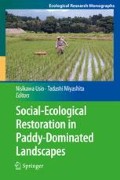Abstract
Eco-labeling systems to indicate the environmental sustainability of products have been implemented in many countries. In this study I evaluated the characteristics of consumer preference for eco-labeled rice using a hypothetical choice experiment conducted on members of the general public in the Tokyo and Osaka metropolitan areas. Subsequently, I used the contingent valuation method (CVM) to analyze consumer evaluations of Toki-friendly rice. In my investigation, the heterogeneity of consumer preference was considered using a latent class model as the consumer choice model. I found consumer heterogeneity and several classes of consumer preference in rice consumption, and it was apparent that some consumers were concerned about agrochemical usage in cultivation, and the biodiversity of paddy fields. This type of consumer might be a promising target for the purchase of eco-labeled rice. The results of this study also suggested that food safety or environmental issues alone were not sufficient to attract consumers. Taste should also be emphasized in the marketing of eco-labeled rice. The CVM analysis indicated that these consumers were more willing to pay for Toki-friendly rice than were general consumers.
Access this chapter
Tax calculation will be finalised at checkout
Purchases are for personal use only
References
Aizaki H (2005) Choice experiment analysis of consumers’ preference for ecologically friendly rice. Agric Inf Res 14(2):85–96 (in Japanese)
Blend JR, Van Ravenswaay EO (1999) Measuring consumer demand for ecolabeled apples. Am J Agric Econ 81(5):1072–1077
Bougherara D, Combris P (2009) Eco-labelled food products: what are consumers paying for? Eur Rev Agric Econ 36(3):321–341
Elbakidze L, Nayga RM (2012) The effects of information on willingness to pay for animal welfare in dairy production: application of nonhypothetical valuation mechanisms. J Dairy Sci 95(3):1099–1107
Gallastegui GI (2002) The use of eco‐labels: a review of the literature. Eur Environ 12(6):316–331
Greene WH, Hensher DA (2003) A latent class model for discrete choice analysis: contrasts with mixed logit. Transp Res B 37(8):681–698
Irimajiri M et al (2012) Assessing attitudes toward and public support of the welfare of farm animal. Anim Behav Manag 48(2):66–78
Iwamoto H (2004) Consumers’ willingness-to-pay for HACCP and eco labeled milk. Hokkaido J Agric Econ 11(2):48–60 (in Japanese)
Jain DC et al (1994) A random coefficients logit brand choice model applied to panel data. J Bus Econ Stat 12(3):317–329
Kamakura WA, Russel GJ (1989) A probabilistic choice model for market segmentation and elasticity structure. J Mark Res 26(3):379–390
Katada M, Tanaka H (2008) Valuing the low fertilizer and agricultural chemical rice produced in creating a habitat for returning Japanese Ibis. Agric Inf Res 17(1):6–12 (in Japanese)
Kehlbacher A et al (2012) Measuring the consumer benefits of improving farm animal welfare to inform welfare labelling. Food Policy 37(6):627–633
Lagerkvist CJ, Hess S (2011) A meta-analysis of consumer willingness to pay for farm animal welfare. Eur Rev Agric Econ 38(1):55–78
Langen N (2013) Ethics in consumer choice. Springer Fachmedien Wiesbaden, Wiesbaden
Loureiro ML et al (2002) Will consumers pay a premium for eco-labeled apples? J Consum Aff 36:203–219
Louviere JJ et al (2000) Stated choice methods: analysis and applications. Cambridge University Press, Cambridge/New York
Lusk J et al (2007) Public preferences and private choices: effect of altruism and free riding on demand for environmentally certified pork. Environ Resour Econ 36(4):499–521
McFadden D (1974) Conditional logit analysis of qualitative choice behavior. In: Zarembka P (ed) Frontiers in econometrics. Academic, New York, pp 105–142
Moon W et al (2002) Willingness to pay for environmental practices: implications for eco-labeling. Land Econ 78(1):88–102
Olesen I et al (2010) Eliciting consumers’ willingness to pay for organic and welfare-labelled salmon in a non-hypothetical choice experiment. Livest Sci 127(2):218–226
Sato S, Okamoto N (1996) Farm animal welfare trend in Japan. Jpn J Livest Manag 32(2):43–52 (in Japanese)
Toma L et al (2012) Consumers and animal welfare. A comparison between European Union countries. Appetite 58(2):597–607
Train K (2012) Discrete choice methods with simulation, 2nd edn. Cambridge University Press, Cambridge/New York
Tsuge T (2006) Estimation of the willingness to pay for the environmentally friendly agricultural products. Doshisha Univ Econ Rev 57(4):263–280 (in Japanese)
Ujiie K (2010) Consideration for the public good and food consumption. J Food Syst Res 17(3):270–275 (in Japanese)
Usio N, Saito R, Akanuma H, Watanabe R (2015) Effectiveness of wildlife-friendly farming on aquatic macroinvertebrate diversity on Sado lsland in Japan. In: Usio N, Miyashita T (eds) Social-ecological restoration in paddy-dominated landscapes, Ecological research monographs. Springer, Tokyo. doi:10.1007/978-4-431-55330-4_7
Yabe M, Hayashi T (2011) Valuation of biodiversity in life brand rice. Sci Bull Faculty Agric Kyushu Univ 66(2):21–32 (in Japanese)
Author information
Authors and Affiliations
Corresponding author
Editor information
Editors and Affiliations
Rights and permissions
Copyright information
© 2014 Springer Japan
About this chapter
Cite this chapter
Ujiie, K. (2014). Consumer Preferences and Willingness to Pay for Eco-labeled Rice: A Choice Experiment Approach to Evaluation of Toki-Friendly Rice Consumption. In: Usio, N., Miyashita, T. (eds) Social-Ecological Restoration in Paddy-Dominated Landscapes. Ecological Research Monographs. Springer, Tokyo. https://doi.org/10.1007/978-4-431-55330-4_18
Download citation
DOI: https://doi.org/10.1007/978-4-431-55330-4_18
Published:
Publisher Name: Springer, Tokyo
Print ISBN: 978-4-431-55329-8
Online ISBN: 978-4-431-55330-4
eBook Packages: Biomedical and Life SciencesBiomedical and Life Sciences (R0)

